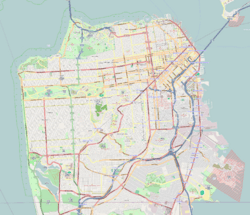James C. Flood Mansion facts for kids
|
James C. Flood Mansion
|
|

James Clair Flood Mansion (Pacific-Union Club), 1000 California St. Photographed from south side of California St. between Taylor St. and Mason St.
|
|
| Location | 1000 California Street, San Francisco, California, USA |
|---|---|
| Built | 1886 |
| Architect | Augustus Laver; Willis Polk |
| Architectural style | Neoclassical |
| NRHP reference No. | 66000230 |
Quick facts for kids Significant dates |
|
| Added to NRHP | November 13, 1966 |
| Designated NHL | November, 1966 |
The James C. Flood Mansion is a very old and important house located at 1000 California Street. It sits high up on Nob Hill in San Francisco, California, USA. Today, it is home to the Pacific-Union Club.
This mansion was built in 1886 for James C. Flood. He was a very rich man who made his money from silver mines. The Flood Mansion was special because it was the first building west of the Mississippi River made of brownstone. It was also the only mansion on Nob Hill that survived the huge 1906 San Francisco earthquake and fire. Because of its history, it was named a National Historic Landmark in 1966.
Contents
About the Flood Mansion
The Flood Mansion takes up an entire city block on Nob Hill. It is surrounded by California, Taylor, Mason, and Sacramento Streets. A strong bronze fence, put up when the mansion was built, surrounds three sides of the property.
Building Design and Materials
The mansion is a large building with three stories. Its outside is covered in brownstone rock. This brownstone came all the way from Portland, Connecticut, and was shipped around Cape Horn. The building shows off a fancy style called Classical Revival architecture. It has special corner designs, a decorative roof edge, and windows framed with columns and detailed carvings. The main entrance faces California Street. It has a wide and deep porch supported by square columns.
History of the Mansion
James C. Flood, who earned his wealth from silver mines in Nevada, had the mansion built. He was inspired by the grand houses he saw on the East Coast of the United States. So, he hired architect Augustus Laver to design it. The mansion was finished in 1888. It was one of Flood's homes until he passed away in 1889.
After the 1906 earthquake and fire, the mansion was badly damaged inside. James Flood's daughter, who was living there, sold the empty shell of the building. The Pacific-Union Club bought it. At first, they thought about tearing it down. Instead, they hired architect Willis Polk to redesign it. He added a third floor and a new inside. They even used more brownstone from the same quarries as the original material.
Surviving the Earthquake
The Flood Mansion was the only large house on Nob Hill to survive the 1906 earthquake and fire. Other mansions on the hill were mostly made of wood. They were built to look like stone, but they were destroyed by the fire. The Flood Mansion's strong stone structure helped it stand tall.
See also
 In Spanish: Mansión James C. Flood para niños
In Spanish: Mansión James C. Flood para niños





